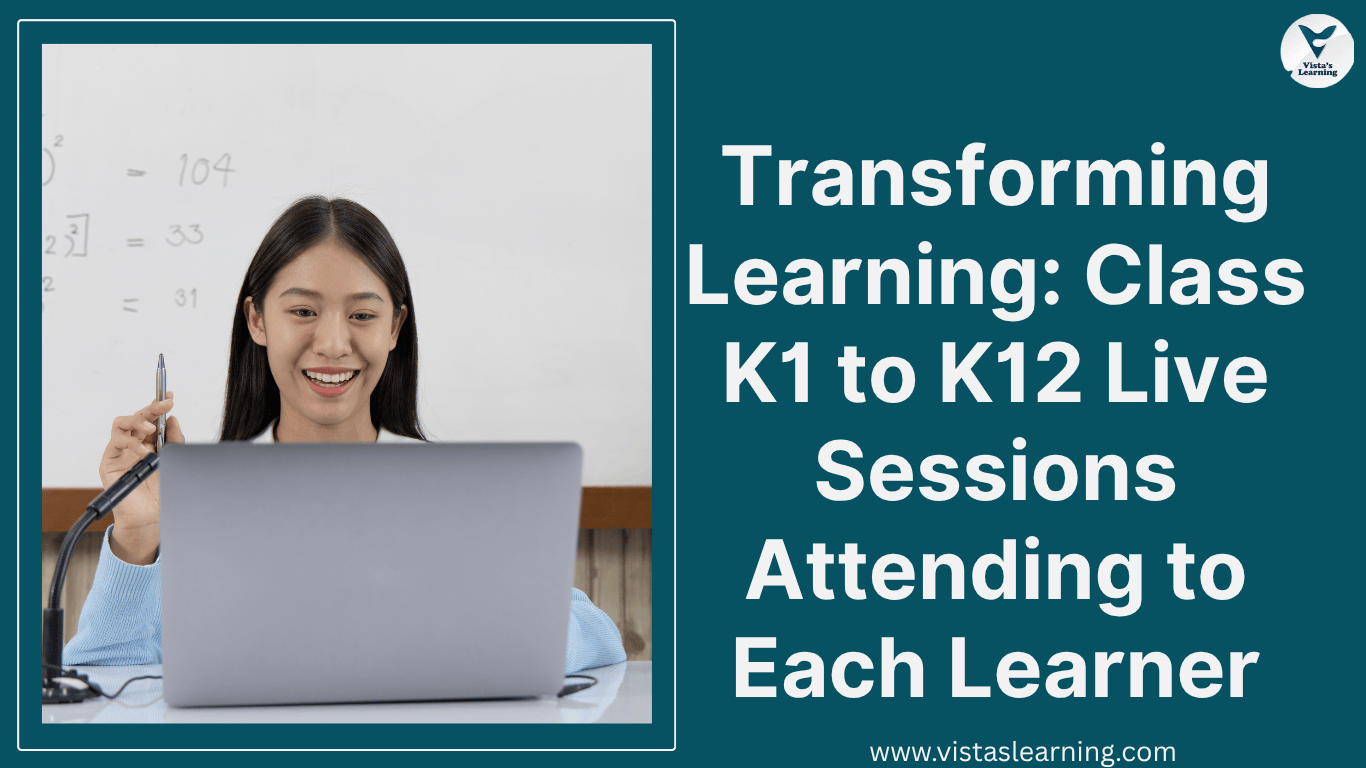The K1–K12 parts are now being taught in the form of interactive lessons. Education solutions are now available online, and as long as the user knows the alphabet, they can be taught at any level. Families can get help at any level through a simple two-way video call, which can be used for everything from reviewing material to counselling with just one touch of a screen. Live online class at Vistas Learning, which helps K–12 and K–1 students learn from the comfort of their own homes, is a great example of how this technology is being used to make life easier.
1.How K–12 students will be taught digitally
Because of smart devices, there are no longer any physical limits on who can get lessons. Thanks to virtual classes and fast internet, students today don’t have to be in a real classroom. They can study from anywhere in the world, even when they’re sick, on vacation, or dealing with personal problems. Virtual classes have made it easier for people of all ages to learn and for teachers to connect with their students more.
2.Younger students need live lessons to learn
Students can talk to their teachers during real-time lessons. For kids in kindergarten through fifth grade, this way of talking to the teacher is helpful because they learn best when they see something done and do it themselves. Grandparents can confirm that polls, songs, games, and videos help them learn.
3.Other Benefits and Instructors Who Attend with Students and Parents
Most likely, the best thing about it is being able to go to class online. Classes can be held from almost anywhere now that learning isn’t tied to a strict schedule or having to deal with unpleasant daily travels. For their part, parents now have more control and freedom over the things their kids learn every day. Students learn hard ideas with the help of a lot of recorded classes, detailed notes, and carefully chosen practice tools that are tailored to each child’s level.
4.Learning goals that are unique to each student
Each pupil is different and learns at their own pace and in their own way. These tools are very complicated, but most of them have smart systems that make lessons fit each student’s needs so they work best. Lessons are fully based on what the pupils need. Students can reach their academic goals and understand difficult ideas with the help of personalised tips, dynamic feedback, personalised tests, and extra lessons.
5.Promoting social and collaborative growth
Virtual learning tools that are more social and engaging are available in newer school systems. Along with talks and group projects, features like breakout rooms help make the space feel like a classroom. These kinds of features help students get better at important life skills like working with others, communicating clearly, and being a leader, all of which are needed in today’s world.
6.Technology Makes Parenting More Accessible
With the rise of technology, parents can see their kids’ learning and growth progress through programs like parent-teacher interaction portals and performance tracking. Now that parents have this access, they want to be involved in their child’s schooling. This means that parents can help their kids with learning problems more quickly and promote growth in all areas.
7.Helping students by giving them personalised learning paths
There are huge benefits to digital learning from anywhere when it comes to closing educational gaps. Students who were thought to be slow learners in a regular classroom are now doing very well with the help of repeat videos, review quizzes, and extra lessons. Other platforms make personalised learning plans by giving tests to find specific learning gaps and creating individualised learning plans.
8.Focused Programs That Aren’t Required
You can learn almost anything online, from creative writing to emotional intelligence and even social and emotional learning. Offering extra classes like business helps make sure that students are well-rounded. They also teach kids the real-world knowledge and skills they need to do well in life, not just what they learn in school or on tests.
9.Technology for digital resources and strategy
Everything digital is at its best right now. Thanks to smart whiteboards, AI feedback, video quizzes, and immersive learning simulations, learning is more involved and students are more interested than ever in what they are studying. These features make it easier and more fun to remember what you’ve learnt and understand difficult themes.
10.Why K–12 virtual schools should be used
Digital platforms have made virtual learning the best of all worlds: it’s easy, it uses modern tools for teaching, and it can be changed to fit your needs. These platforms keep to set routines while giving students the freedom to learn in different ways, such as through play-based learning for younger kids and studying for tests for high school students. For many families, this is a great addition to or even a replacement for regular learning.
11.Giving teachers digital tools to use
The internet has made it easier to move around, which is good for school teachers. With this new technology, teachers can now make lesson plans that are specific to each student and don’t have to be limited by location or time. Adaptive class automation also helps make classes more responsive by giving comments on performance in real time.
12.Applying strategies from video games to teaching strategies
Using game tactics to improve teaching of almost any subject at any grade level works well. Using fun activities to teach young kids makes them more interested and helps them learn better. Gaming elements like badges, points, and leaderboards also make lessons more fun by turning them into fun jobs. This mostly happens with younger students who are driven by desire. This helps them feel better about themselves and makes learning more consistent.
13.How Self-Evaluations Can Help You Feel Better About Yourself
These days, internet tests are important for both learning and judging how well a student is doing because they give immediate feedback. Learners can see where they went wrong and fix it. Getting rid of the standard exam setting makes students less anxious, which helps them do better than they thought they would, which boosts their confidence.
14.Educating all of our students is important
It has always been hard to teach kids who have learning disabilities, long-term illnesses, or trouble moving around. But the rise of digital education has opened up a huge world of possibilities for these students. Using educational screen readers, movies with closed captions, and pacing that can be changed makes the experience more open, which helps all students learn better.
15.Putting Safety and Privacy Protection First
Kids and teens need to be very careful about staying safe online. The best teaching sites have strict safety measures like encrypting data, making logins safe, and using filters that are made just for kids. Along with tracking progress, parental controls let you keep an eye on interactions, material, and access, which makes the app even safer.
How to Make Learning Better in 2025 and the Years That Follow
When K1 through K12 virtual education starts, it changes the way we learn because students can access real-time learning in a deep and interesting way. Customised learning choices are available from the very beginning of schooling all the way up to important tests for college.
With new digital ways to learn, the future of education is being made. Digital tools for education offer interesting ways to learn that meet the needs of self-motivated immersion.
FAQs:
1.What is a K1 to K12 live class?
A K1 to K12 live class is an interactive class for students in kindergarten up to 12th grade.
2.How is a virtual class different from the traditional school model?
It offers flexibility, remote learning, and individualized instruction tailored to the learner’s pace.
3.Are these sessions useful for preschoolers?
Yes, they use age-appropriate, captivating visuals, stories, songs, and games to help grasp the concepts and keep the children focused.
4.Can parents track growth and development milestones on these platforms?
Absolutely – most systems have real-time updates, recorded sessions, and communication channels with the instructors and offer automatic updates.
5.Is ample network coverage needed?
Yes. A reliable internet connection is very critical to enable participation without disruptions in the sessions.

